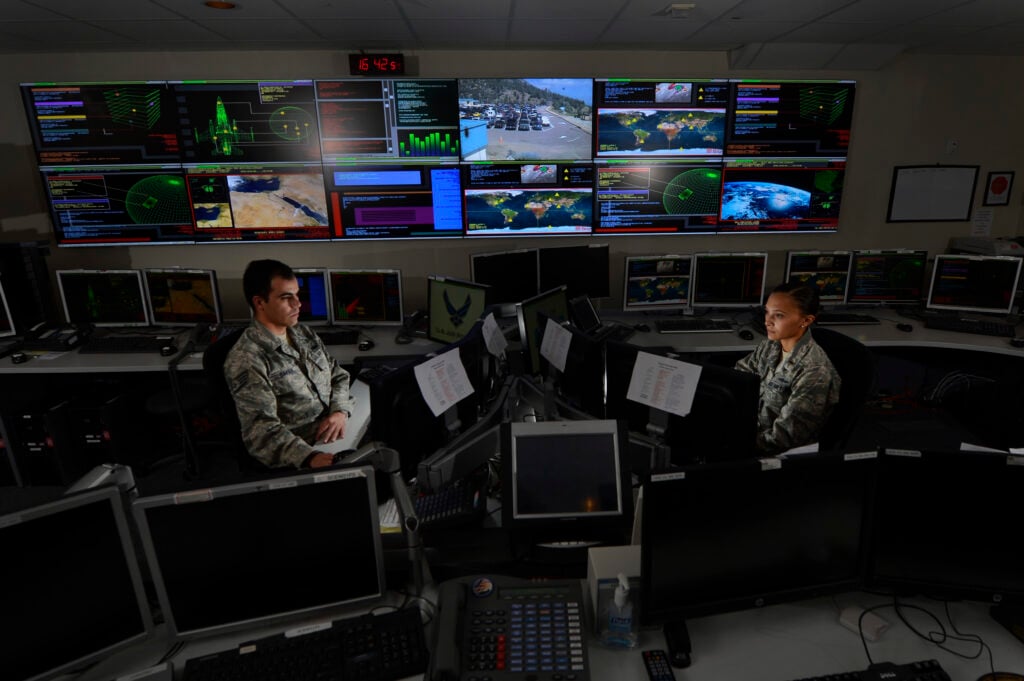Space Mystery: Are Russian Doll Sats a Threat?
Posted on

Cheyenne Mountain complex NORAD space operations
WASHINGTON: Just days after the White House rolled out plans to make its proposed Space Force a sixth military command, a top State Department official expressed concerns over Russian satellites that have been tooling around in interesting patterns.
“We are concerned with what appears to be very abnormal behavior by a declared ‘space apparatus inspector,’” Yleem D.S. Poblete, assistant secretary of State for arms control, verification and compliance, said Tuesday in Geneva. “We don’t know for certain what it is and there is no way to verify it.”
The warning came amid a laundry list of complaints over Russian activities in space which Poblete unveiled at a United Nations conference on disarmament, in response to Russian President Vladimir Putin’s recent boats of a slew of new missiles and anti-satellite weapons that are on the verge of being deployed.
Some experts, however, say they’re not cure why the State Department would be highlighting activities now that had been reported almost a year ago. It is also unclear what “very abnormal behavior” the satellites are demonstrating. The State Department didn’t respond to questions for more detail on Poblete’s charges.
The “space apparatus inspector” highlighted by Poblete is part of a satellite Moscow lobbed into orbit in June 2017, which it announced publicly. In August last year, the sat detached a smaller “inspector,” along with a second probe in October. Dubbed Cosmos 2521 and 2523 respectively, the two smaller satellites are thought to be part of a Russian remote sensing mission, according to an April 2018 report from the Secure World Foundation.
Jeffrey Edmonds, an analyst at CNA and former director for Russia on the National Security Council, told me that the satellites continue to maneuver. They appear to be part of a Russian program not only to check in on Russian sats, but understand what other countries are doing in space.
“The Russians clearly understand the U.S. has an advantage in space,” he said. For the Russians, “the most important part of space is what it contributes to information dominance and information warfare. They spend a lot of energy on that.”
The “inspector” satellites have been active for years, and mirror many Rendezvous and Proximity Operations (RPO) by American and Chinese satellites that monitor their own countries space assets while peeping on those of competitors.
The Secure World Foundation reported that the Cosmos 2521 satellite “did not include explicit testing of offensive capabilities or aggressive maneuvers, it is possible that the technologies they tested could be used offensively or aggressive in the future. One potential offensive use would be to get a radio-frequency jammer close to a satellite, thereby greatly amplifying its ability to interfere with the satellite’s communications.”
There has been a resurgence of Russian RPO activities since 2013, Edmonds said, which has caused some anxiety in the Pentagon and elsewhere. Since 2013, Russia has launched several satellites into low earth orbit and geostationary orbit that have demonstrated the ability to rendezvous with other space objects, at times doing so after periods of dormancy.
It’s not clear why the State Department decided to make a case about the satellites this week, but it is in keeping with the Trump Pentagon and State Department’s focus on highlighting and checking Russian adventurism, even while the president himself lauds Putin or fails to criticize Russian aggression.
Moscow’s new push to develop and deploy new space assets comes after it has learned some hard lessons in combat. The inability of Russian troops to gain intelligence and communicate in its 2008 war in Georgia, and its increasing reliance on GPS technology while operating in Syria, have highlighted Russian shortcomings in space-based intelligence and reconnaissance. In Syria, Moscow has had to pull commercial satellites into service to keep troops connected, as the country’s intelligence and reconnaissance stable still remains thin.
As Breaking D readers know, the Chinese also have satellites that appear to have demonstrated the ability to approach other satellites.
So while there is growing concern over the weaponization of space, Edmonds said that Russia appears less concerned with militarizing space than it is in building up its own ISR assets in order to catch up with the United States.
“They’re coming to terms that it’s no longer about defeating space assets” launched by Washington, he said, “but how they build their own space assets.”
Still, the Pentagon is concerned. Speaking at an event in June, Lt. Gen. Robert Ashley, head of the Defense Intelligence Agency, said that both Russia and China are developing weapons for use in space that will be ready “in the near future.” Both countries are working on “the ability to interdict satellites both from a ground standpoint and from a space standpoint,” he said.
There is no indication when and if any of these technologies will be deployed, but they have certainly caught the eye of Washington.
Subscribe to our newsletter
Promotions, new products and sales. Directly to your inbox.
